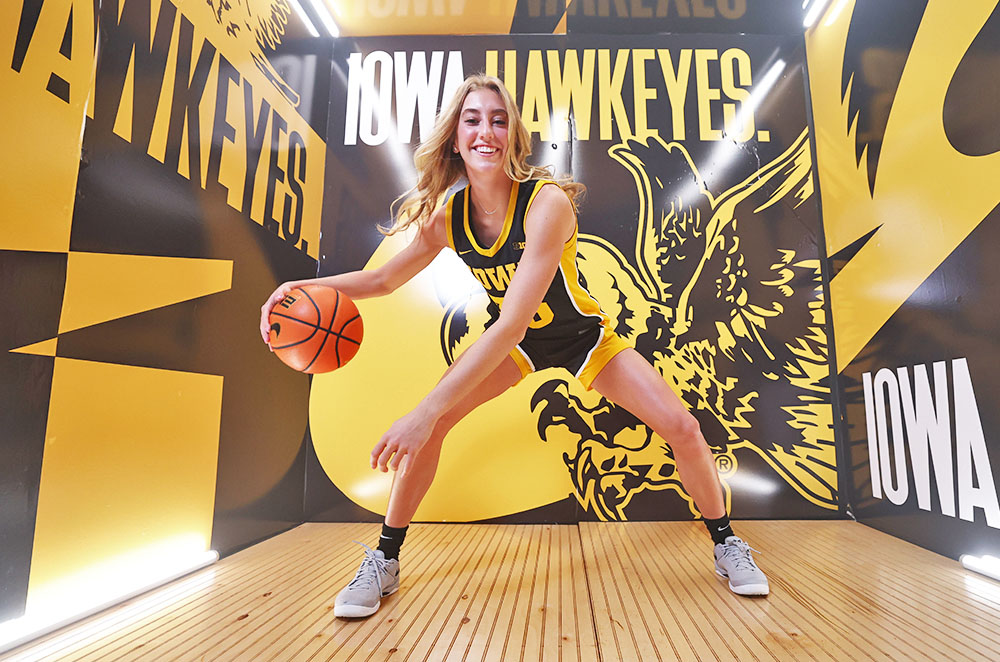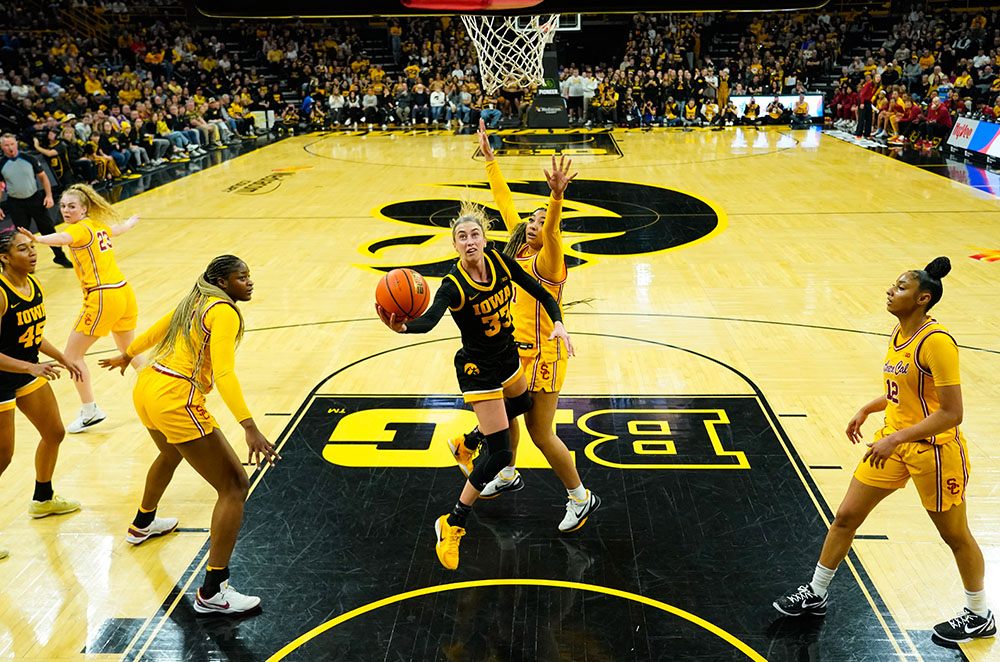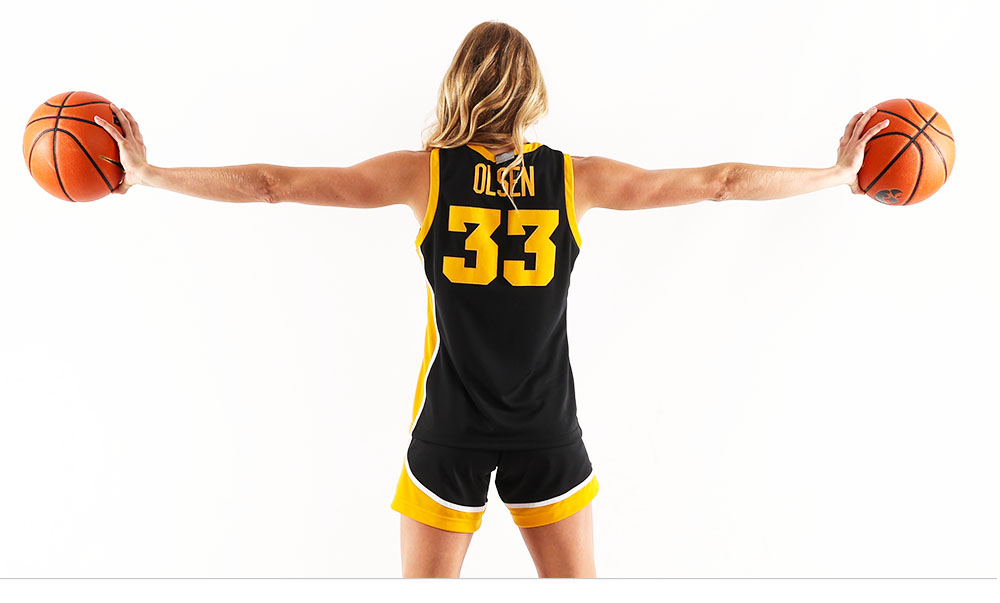Explaining the Transfer Portal: “It's Like Speed Dating.”
 PHOTO: Jerod Ringwald/hawkeyesports.com
Lucy Olsen, who transferred during the offseason from Villanova to Iowa, has led the Hawkeyes this season with 18 points per game.
PHOTO: Jerod Ringwald/hawkeyesports.com
Lucy Olsen, who transferred during the offseason from Villanova to Iowa, has led the Hawkeyes this season with 18 points per game.
Lucy Olsen still remembers the first phone call she received last spring after entering the women’s basketball transfer portal.
“Iowa was the first to reach out,” says Olsen, who averaged 23.3 points per game last season at Villanova, third best in all of Division I. “I couldn’t believe that Lisa Bluder was calling me. I was thrilled.”
Once Olsen got off the phone, she couldn’t shake the idea of becoming a Hawkeye.
“I loved my three years at Villanova, but I really wanted to find a school that appreciated women’s basketball and women’s sports,” says Olsen, a native of Collegeville, Pennsylvania. “I wanted to find a program that would allow me to develop and grow my skills and would prepare me to play professionally. I also wanted to fit well into the offense. The more I thought about it, the more I knew Iowa was the right choice.”
In her senior season, Olsen has emerged as the Hawkeyes’ leading scorer and an all-Big Ten selection, aiming to guide the Iowa women’s basketball team to another strong postseason run. Here’s a look at how the transfer portal works—and how it paved the way for Olsen’s success in Iowa City.
What is the transfer portal?
Prior to 2018, student-athletes had to seek permission to contact another college or university. Andy Banse (04BA, 06MA), associate athletics director for compliance within the UI Department of Intercollegiate Athletics, says that the old process was not transparent and consistent for student-athletes.
“If I was an Iowa student-athlete, I’d go to a coach or compliance officer and say I wanted to speak to other institutions,” says Banse. “Coaches could grant you access to certain schools, deny you access to certain schools, or deny the request entirely. There have been a lot of changes to try and remove barriers for student-athletes—whether it’s for academic, athletic, or financial reasons.”
Previously, the NCAA had utilized a one-time transfer rule in sports other than baseball, basketball, and football, which allowed a student-athlete to transfer one time during their academic career and compete immediately at their next school. Student-athletes in baseball, basketball, and football were forced to sit out for 12 months when they transferred from one Division I school to another.
Due to the lack of consistency between sports, the NCAA membership revised the rule in 2021 and gave all student-athletes the opportunity to transfer one time and compete immediately.
So, what is the transfer portal? It’s an online database that allows student-athletes to declare their interest in moving from one institution to another—giving student-athletes more options in their collegiate experiences.
Every sport has specific transfer timeframes. While both men’s and women’s basketball have one transfer window, other sports such as football have two—one in December and one in April.
At Iowa, each student-athlete who wishes to transfer informs their coach or a compliance officer, takes part in required education, and then enters the database. Once a student-athlete enters the transfer portal, other colleges and universities can begin to make contact.
While thousands of Division I student-athletes entered the transfer portal in 2024, just 71 out of 600 Hawkeye student-athletes searched for a new institution.
 PHOTO: Stephen Mally/hawkeyesports.com
Lucy Olsen drives to the basket during Iowa's upset of No. 4 USC earlier this season.
PHOTO: Stephen Mally/hawkeyesports.com
Lucy Olsen drives to the basket during Iowa's upset of No. 4 USC earlier this season.
How the women’s basketball transfer portal worked for Olsen
When Villanova ended its season last year, Olsen wasn’t sure what would be next for her academic and athletic career.
“I knew I only had one year left, and I was seeing that women’s basketball—on the national stage—was erupting,” says Olsen. “At Villanova, we were overshadowed by the men’s basketball team, so when I entered the women’s basketball transfer portal, I was looking for a school that really stood out in women’s sports.”
Olsen had to decide quickly, since the women’s basketball transfer portal opens in late March and closes toward the end of April. It’s much like being recruited out of high school, but as Olsen explains, it’s a much more condensed timeframe.
“It’s like speed dating,” says Olsen. “After you get a phone call from a coach, you do research and see who is exiting and entering the program. Then you decide if you want to set up a Zoom call with the coaches and your parents, followed by an official visit. It’s a lot to narrow down, especially if you’re trying to visit multiple schools.”
Banse supports coaches and student-athletes throughout the entire process. While compliance officers advise coaches on academic and official visit requirements, they also perform academic evaluations on every incoming student-athlete.
“The academic piece is always the most challenging part of the transfer process,” says Banse. “Coursework may not completely transfer, so we do an academic evaluation to make sure each student-athlete is pursuing a degree that is meaningful to them and their career interests.”
Olsen loved the idea of joining a program that had been on the national stage as runner-up in both the 2023 and 2024 NCAA title games. It also worked out for Olsen because Iowa women’s basketball needed a point guard.
“I learned that Iowa had a freshman point guard, Aaliyah Guyton, coming in, and they wanted someone for one year who had some experience,” says Olsen. “They wanted someone to help her get ready while recovering from an injury. That worked out well for me.”
But just a few weeks after committing to the Iowa women’s basketball program, Olsen learned that Bluder would be retiring. Two days later, Jan Jensen was promoted to the position of P. Sue Beckwith, MD, Head Women’s Basketball Coach.
With the change to Jensen—who was Bluder’s long-time assistant at both Drake and Iowa—Olsen had a secondary transfer window of 30 days open that could have allowed her to move to another school.
“I wasn’t expecting that,” says Olsen. “I had met all the coaches and players on my visit, and I loved what I saw from Coach Jensen. I wanted to make sure no one was transferring, and once I saw that everyone was staying put, I knew the culture was pretty good.”
 PHOTO: Brian Ray/hawkeyesports.com
Iowa guard Lucy Olsen during the women's basketball team photo shoot in September.
PHOTO: Brian Ray/hawkeyesports.com
Iowa guard Lucy Olsen during the women's basketball team photo shoot in September.
Name, image, and likeness: Changing the game
Prior to 2021, it was an NCAA violation for student-athletes to receive compensation for name, image, and likeness (NIL). When the U.S. Supreme Court ruled in 2021 that a ban on student-athlete compensation was illegal, the NCAA has since allowed student-athletes to earn money from NIL.
Approximately 225 out of Iowa’s 600 student-athletes work in partnership with the Swarm Collective, Iowa’s independent organization that facilitates NIL deals. The number of student-athletes utilizing NIL may be higher, but student-athletes are not yet required to report NIL deals. That will change July 1, 2025.
“NIL has been an awesome opportunity, and we fully support it at Iowa because we know the impact it can have on our student-athletes,” says Banse. “Our student-athletes are able to learn so many life skills—such as learning how to market yourself—while maximizing every facet of their experience here at Iowa.”
According to NCAA Assist—an online tool that tracks student-athlete compensation—the median amount earned by Division I student-athletes is just $480. While some student-athletes are earning significant dollars through NIL, most others are not. For Olsen, NIL wasn’t a deciding factor.
“I knew that I was missing out on financial opportunities, but when it came to choosing a new school, I didn’t think too much about it,” says Olsen, whose dad, Roland Olsen, and an agent manage her NIL deals. “My goal was to find a great school and any money I make would be a bonus.”
While so much continues to change in the competitive landscape of collegiate athletics, Banse hopes that the next few years give everyone—from student-athletes to coaches to administrators—the opportunity to dig into the outcomes.
“There have been so many significant rule changes in the last three to five years that have completely shifted the landscape of college sports,” says Banse. “The pace of change hasn’t really given us an opportunity to see the impact of all the rule changes. We need to the let the rules work for a bit and then tweak them from there.”
Support Iowa women’s basketball
By making a gift to Iowa Women’s Basketball Development Fund, you can support the greatest needs of the program. Your contributions are tax deductible and will help our student-athletes and coaches continue to contend for championships both now and in the future.

